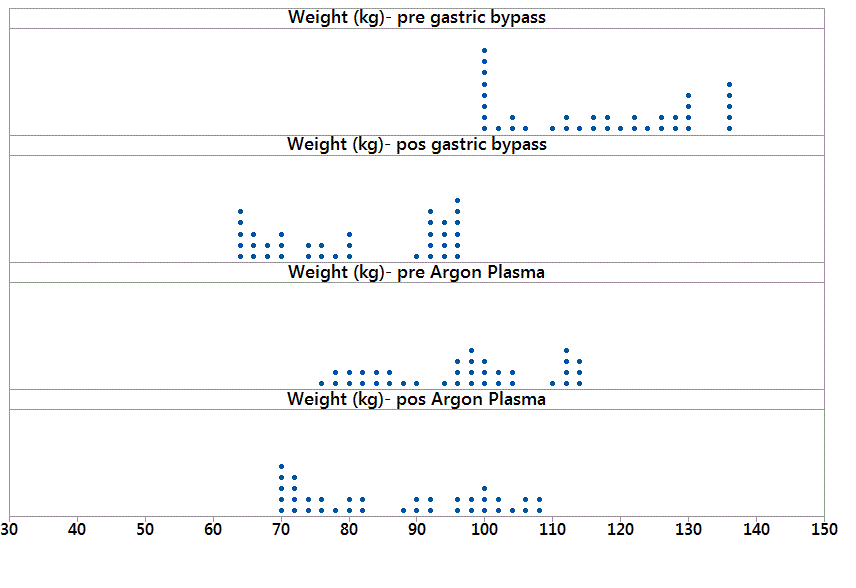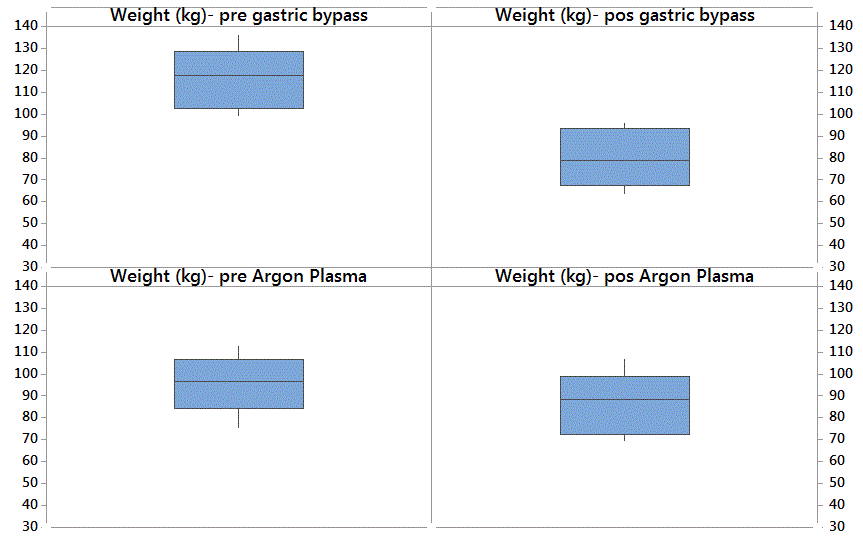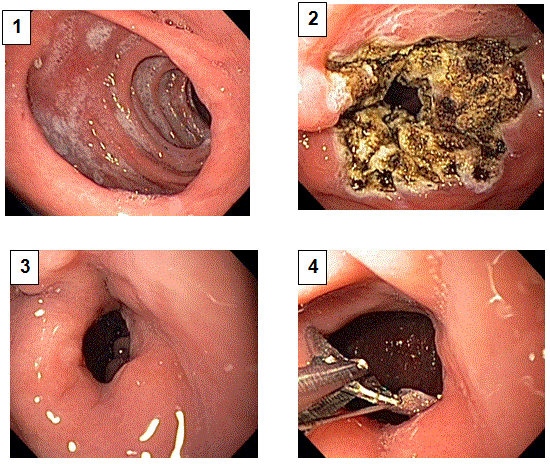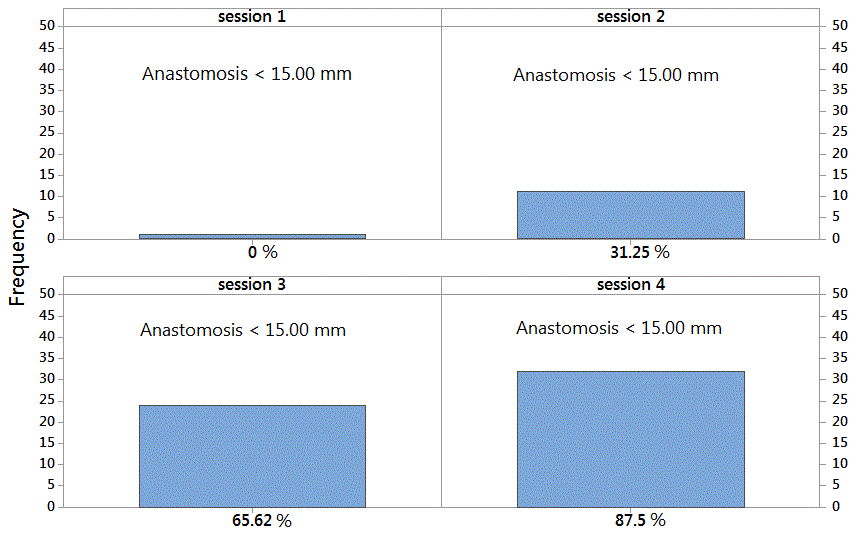Research Article Open Access
Argon Plasma Effect about Anastomosis was Significant to Inhibit the Weight Regained in Patients Undergoing Gastric Bypass
| Larissa Moraes De Souza1, Luiz Gustavo de Quadros1,2, Roberto Luiz Kaiser Junior2, Josemberg Marins Campos3, Idiberto José Zotarelli Filho2,3,4*, Fernando Tadeu Vannucci Coimbra1, Rodrigo Tadeu Rodrigo Silvestre1 and Mário Flamini Júnior2 |
|
| 1Santa Casa de Misericórdia Hospital, Bariatric Surgery and Endoscopy Department, São Jose do Rio Preto SP, Brazil | |
| 2Kaiser Clinic and Hospital, São José do Rio Preto SP, Brazil | |
| 3Federal University of Pernambuco, Bariatric Surgery Department, Pernambuco PE, Brazil | |
| 4State University of Sao Paulo-Ibilce-Unesp, Rua Cristovao Colombo 2265, Sao Jose do Rio Preto SP, Brazil | |
| Corresponding Author : | Prof. Dr. Idiberto Jose Zotarelli Filho University of Sao Paulo-IBILCE-UNESP Rua Cristovao Colombo 2265, Sao Jose do Rio Preto SP, Brazil Tel: 55(17)-98166-6537 E-mail: m.zotarelli@gmail.com |
| Received April 17, 2015; Accepted May 14, 2015; Published June 05, 2015 | |
| Citation: De Souza LM, de Quadros LG, Kaiser RL, Campos JM, Zotarelli IJ, et al. (2015) Argon Plasma Effect about Anastomosis was Significant to Inhibit the Weight Regained in Patients Undergoing Gastric Bypass. J Obes Weight Loss Ther 5:264. doi:10.4172/2165-7904.1000264 | |
| Copyright: © 2015 De Souza LM, et al. This is an open-access article distributed under the terms of the Creative Commons Attribution License, which permits unrestricted use, distribution, and reproduction in any medium, provided the original author and source are credited. | |
Visit for more related articles at Journal of Obesity & Weight Loss Therapy
Abstract
About 40% of the population is overweight. It is estimated that there are about 80,000 deaths per year in Brazil for reasons arising from obesity. Bariatric surgery has been the most effective method for the treatment and prevention of complications caused by morbid obesity. The gastric bypass has shown good short term results in significant reduction of body weight. However, in the long run about 10 to 20% of patients tend to weight regained. This number seems to be relatively low; the reality is significantly higher when surgery is not accompanied by a long-term change in lifestyle. Thus, it was hypothesized that by applying argon plasma on the anastomosis, the weight regained is avoided. The aim of this work was to study the effect of argon plasma fulguration in the weight regained in patients undergoing gastric bypass. Of the 37 patients who underwent gastric bypass 24(75%) were female and 8(25%) were male. Considering the gastric bypass, the mean preoperative weight was 117.61 Kg. After the average weight surgery was 79.94 Kg. The mean difference of pre and post-operative weight was 37.66 kg, the difference being significant (p<0.0001). Regarding the use of argon, the average pre intervention weight was 94.52. The average difference pre and post intervention was 5.87 kg, with statistically significant (p<0.0001). There was a significant correlation between use of the ring and smaller diameter of the anastomosis at the third session (p=0.019). The average size of the pouch was 5. There was no statistical correlation between size of the pouch and efficacy of argon use. It was concluded that after application of argon was no significant reduction in the average weight of the patients, about 50% of patients, especially female.
Obesity is a chronic disease that reached epidemic characteristics in Brazil and the world in recent years [9,10]. According to the Brazilian Society of Metabolic and Bariatric Surgery, in 2007 about 12.1% of the population (15 million people) was obese, 3% (4 million people) carrier morbid obesity [11].
Bariatric surgery has been the most effective method for the treatment and prevention of complications caused by morbid obesity, increasing the longevity and quality of life of these patients [12]. Among the various surgical techniques gastric bypass has shown good short term results in significant reduction of body weight. However, in the long run about 10 to 20% of patients tend to have weight regain [13]. This number seems to be relatively low; the reality is significantly higher when surgery is not accompanied by a long-term change in lifestyle.
Mechanisms that lead to weight regained is uncertain, but some factors can influence how high caloric intake, physical inactivity, metabolic, hormonal, surgical technique, gastro-gastric fistulas, loss of function of the restrictive ring when present, dilation of gastric pouch and dilation of the gastrojejunostomy [14,15].
Several methods have been proposed for reducing weight in patients with post gastric bypass regained. Among the endoscopic procedures, in order to reduce the diameter of the gastric pouch or gastrojejunostomy stand out endoluminal injection of sodium morrhuate the anastomosis, EndoCinch, StomaphyX, ROSE procedure, Overstitchda Apollo Endosurgery, CSTO clip and fulguration with argon plasma on the gastrojejunostomy [16].
Argon, an odorless, inert, non-toxic, inexpensive and easily ionizable, has been used in conventional surgeries since the 80's and in the field of endoscopy, was introduced in 1991 [17]. The fulguration with argon (Figure 1) consists of electrocoagulation method without contact to the radio frequency energy is applied to the tissue through the ionized gas via electric current, defined as plasma [16]. The depth of penetration is between 1 and 3 mm, although some studies show clearly that the higher the intensity, the greater the depth of the lesion eventually reaching the muscularis mucosa [18].
In the case of gastrojejunal anastomosis, argon application phase promotes a reduction in its diameter, leading to a "stenosis" and consequent delay in gastric emptying, early society and weight reduction [16]. The endoscopic point of view, information such as diameter of the anastomosis and pouch size, complications after bariatric surgery and amount of argon applications can contribute to a better indication criteria to be adopted in patients regained weight after gastric bypass.
Furthermore, the quality of life of patients with weight regained subjected to argon application can be significantly improved because the reduction in the diameter of gastrojejunostomy possibly occur weight loss. Considering the relevance of studies on the effect of argon in the weight regained in patients undergoing gastric bypass, it is appropriate to this research because Baretta et al. [14] has had good results.
The aim of this work was to study the effect of argon in the weight regained in patients undergoing gastric bypass, considering demographic, clinical, surgical and endoscopic.
Then was held application of argon gas Argon 2 (WEM, Ribeirão Preto, Brazil) with disposable endoscopic catheter throughout circumference gastrojejuno anastomosis by 1 cm, using output of 90 W and 2 L min-1. After this procedure and recovery room, all patients were released, always with a companion. Pump inhibitor proton 40 mg was prescribed for 30 days, and fasted for 10 days sucrafilm. All patients were instructed and kept in touch with doctor to report any signs or symptoms.
Regarding the use of argon, the average pre intervention weight was 94.52 ± 18.49 kg (var: 71-130 kg) (Figure 3). This measure represented an average BMI of 42.30 ± 4.30 (var: 33.3 to 53.91) (Figures 1 and 2). The mean difference in weight between post gastric bypass and pre argon periods was 14.58 kg. The post intervention with argon measurements, considering the data from the last session, show that the average weight of the patients was 88.75 ± 18.33 kg (var: 62-122 Kg). The average difference pre and post intervention was 5.87 kg, with statistically significant (p<0.0001). Regarding the number of sessions used, we observed median of 2 sessions (var: 1-4 sessions).
It is considered successful therapy with argon as the ability to reduce interference in at least 50.00% regained weight after gastric bypass, it is observed that this effect induced technique in 16 (50.00%) patients relative to Argon pre weight. It was noted that there was no correlation between clinical variables and results of therapy with argon (Figure 3). The goal of treatment with the argon reach an anastomosis was <15.00 mm and thereby achieving weight loss. In the first argon session, no patient had less anastomosis than 15 mm; the second 31.25% of patients; 65.62% in the third and fourth session 87.50% of patients. It is noteworthy also that there was no significant correlation between the number of argon sessions and technical efficiency. There was no correlation between whether or not the ring and magnitude of loss of weight pre and post use of argon.
In the correlation between use of the ring and diameter of the anastomosis, we observed a significant correlation between use of the ring and smaller diameter of the anastomosis at the third session (p=0.019, and p<0.05). The average size of the pouch was 5 ± 0.98 cm (var: 3-8 cm). There was no statistical correlation between size of the pouch and efficacy of argon use (Figure 4).
In this study, does not reach the weight loss goal of 50.00% of weight regained in half of the patients may be due to factors such as non-compliance of patients to return with the multidisciplinary team and clinical characteristics such as alcoholism and psychiatric disorders.
In obesity classification according to the body mass index (BMI). It is considered overweight patients with a BMI of 25-29.9 kg/m2 class I obesity 30 to 34.9 kg/m2, Class II 35 to 39.5 kg/m2 and class III obese or morbidly when greater than 40 kgm-2 [19].
Obesity is associated with various diseases such as diabetes, hypertension, obstructive sleep apnea, cardiovascular diseases, arthropathy, cholecystolithiasis, dyslipidemia and psychiatric diseases [20]. Furthermore, this condition reduces life expectancy of 5 to 20 years [21].
The treatment of obesity may be medical, nutritional or surgical. The higher the degree of overweight, the higher is the severity of the disease [21,22]. According to the 1766/2005 and 1942/2010 ordinances of the Federal Council of Medicine (CFM), surgical treatment for morbid obesity is indicated for patients with BMI greater than 40 kg m-2 or above 35 kg m-2 with co-morbidades life-threatening [16].
Baretta [16] studied 30 patients undergoing treatment with argon after gastric bypass, found that a reduction in the diameter of the anastomosis and the consequent reduction of body weight. However, compared to argon success rate in the present study is not possible, since said author does not mention if the criterion was 50% loss of weight regained. In addition, endoscopic data as pouch size and presence ring analyzed here were not investigated by the author.
In the case of gastrojejunal anastomosis, argon application phase promotes a reduction in its diameter, leading to a "stenosis" and consequent delay in gastric emptying, early satiety and weight reduction [14]. In summary, despite the relatively small sample, the results may contribute to the establishment of clinical and endoscopic criteria to be adopted in patients’ regained weight after gastric bypass. It is noteworthy that long-term randomized prospective studies are needed.
References
- OMS-Organização Mundial de Saúde. Disponível.
- IBGE-InstitutoBrasileiro de Geografia e Estatística. Disponível.
- Cambi MPC, Marchesini SD, Baretta GAP (2015) Post-bariatric surgery weight regain: evaluation of nutritional profile of candidate patients for endoscopic argon plasma coagulation. ABCD Arq Bras Cir Dig Original Article 28: 40-43.
- Correia Horvath JD, Dias de Castro ML, Kops N, Kruger Malinoski N, Friedman R (2014) Obesity coexists with malnutrition? Adequacy of food consumption by severely obese patients to dietary reference intake recommendations. NutrHosp 29: 292-299.
- Marchesini JB, Nicareta JR (2014) Comparative study of five different surgical techniques for the treatment of morbid obesity using BAROS. Arq Bras Cir Dig 27 Suppl 1: 17-20.
- Marchesini SD, Baretta GA, Cambi MP, Marchesini JB (2014) Endoscopic plasma argon coagulation in treatment of weight regain after bariatric surgery: what does the patient think about this? Arq Bras Cir Dig 27 Suppl 1: 47-50.
- Bastos EC, Barbosa EM, Soriano GM, dos Santos EA, Vasconcelos SM (2013) Determinants of weight regain after bariatric surgery. Arq Bras Cir Dig 26 Suppl 1: 26-32.
- Blomain ES, Dirhan DA, Valentino MA, Kim GW, Waldman SA (2013) Mechanisms of Weight Regain following Weight Loss.ISRN Obes 2013: 210524.
- Deitel M (2003) Overweight and obesity worldwide now estimated to involve 1.7 billion people. ObesSurg 13: 329-330.
- World Health Organization.Global burden of disease project. April 25, 2003.
- PesquisaObesidade no Brasil-SociedadeBrasileira de CirurgiaBariátrica e Metabólica, 2007.
- Ferraz EM, Arruda PCL, Bacelar TS, Ferraz AAB, Albulquerque AC, et al. (2003) Surgical treatment of morbid obesity. Rev Col Bras Cir 98-105.
- Magro DO, Geloneze B, Delfini R, Pareja BC, Callejas F, et al. (2008) Long-term weight regain after gastric bypass: a 5-year prospective study. ObesSurg 18: 648-651.
- Baretta GA, Alhinho HC, Matias JE, Marchesini JB, de Lima JH, et al. (2015) Argon plasma coagulation of gastrojejunal anastomosis for weight regain after gastric bypass. ObesSurg 25: 72-79.
- Barhouch AS, Zardo M, Padoin AV, Colossi FG, Casagrande DS, et al. (2010) Excess weight loss variation in late postoperative period of gastric bypass. ObesSurg 20: 1479-1483.
- Baretta GA (2013) Tratamentoendoscopico do reganho de peso pos by-pass gastricoatraves da fulguracão com argonio da anastomose gastrojejunal Curitiba.
- Grund KE, Storek D, Farin G (1994) Endoscopic argon plasma coagulation (APC) first clinical experiences in flexible endoscopy. EndoscSurg Allied Technol 2: 42-46.
- Dotti VP, Baretta GA, Yoshii SO, Ivano FH, Ribeiro HD, et al. (2009) [Endoscopic argon plasma thermo-coagulation of Barrett's esophagus using different powers: histopathological and post procedure symptons analysis]. Rev Col Bras Cir 36: 110-117.
- WHO mortality database: tables [online database]. Geneva, World Health Organization, 2011.
- Varaschim M, Nassif PAN, Moreira LB, Nascimento MM, Vieira GMN, et al. (2012) Alterações dos parâmetrosclínicos e laboratoriaisempacientesobesos com diabetes melitotipo 2 submetidos à derivaçãogastrojejunalem y de Roux semanel. Rev Col Bras Cir 39: 178-82.
- Runkel N, Colombo-Benkmann M, Hüttl TP, Tigges H, Mann O, et al. (2011) Bariatric surgery. DtschArzteblInt 108: 341-346.
- Jeffreys M, McCarron P, Gunnell D, McEwen J, Smith GD (2003) Body mass index in early and mid-adulthood, and subsequent mortality: a historical cohort study. Int J ObesRelatMetabDisord 27: 1391-1397.
Tables and Figures at a glance
| Table 1 |
Figures at a glance
 |
 |
 |
 |
| Figure 1 | Figure 2 | Figure 3 | Figure 4 |
Relevant Topics
- Android Obesity
- Anti Obesity Medication
- Bariatric Surgery
- Best Ways to Lose Weight
- Body Mass Index (BMI)
- Child Obesity Statistics
- Comorbidities of Obesity
- Diabetes and Obesity
- Diabetic Diet
- Diet
- Etiology of Obesity
- Exogenous Obesity
- Fat Burning Foods
- Gastric By-pass Surgery
- Genetics of Obesity
- Global Obesity Statistics
- Gynoid Obesity
- Junk Food and Childhood Obesity
- Obesity
- Obesity and Cancer
- Obesity and Nutrition
- Obesity and Sleep Apnea
- Obesity Complications
- Obesity in Pregnancy
- Obesity in United States
- Visceral Obesity
- Weight Loss
- Weight Loss Clinics
- Weight Loss Supplements
- Weight Management Programs
Recommended Journals
Article Tools
Article Usage
- Total views: 14778
- [From(publication date):
June-2015 - Aug 16, 2025] - Breakdown by view type
- HTML page views : 10152
- PDF downloads : 4626
